The fierce battle for Kerch and Feodosia
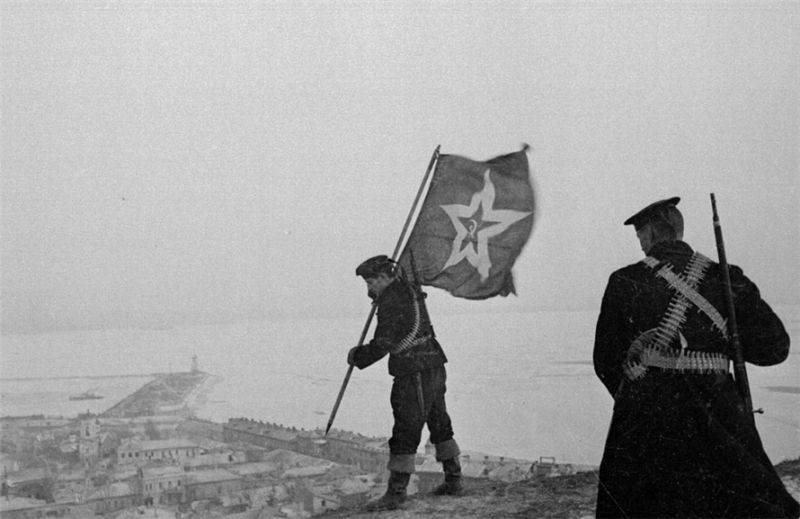
Soviet marines Vladimir Ivashev and Nikolai Ignatievich Ganzyuk (Gandzyuk) install a ship jack on the highest point of Kerch - Mount Mithridat. The first liberation of Kerch during the Kerch-Feodosiya operation
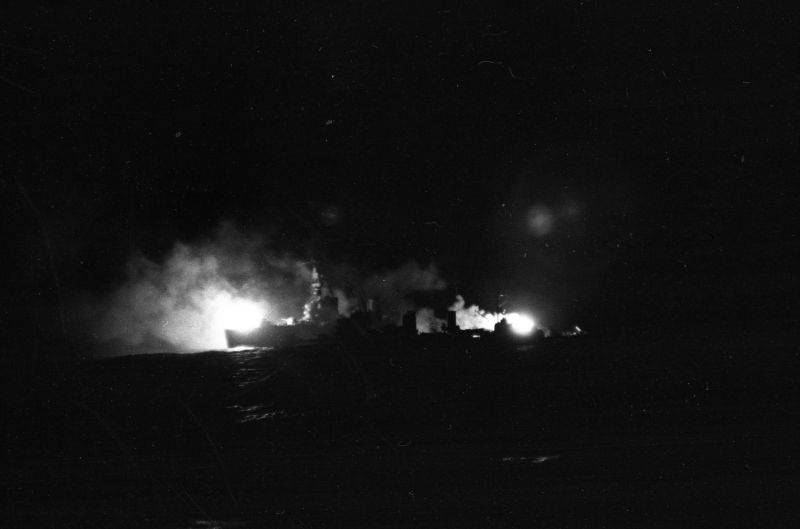
Soviet cruiser firing during the Kerch-Feodosiya landing operation
Operation plan
The general counteroffensive of the Red Army, which began in November 1941 near Tikhvin and Rostov, and continued near Moscow in December 1941, also affected the Crimean peninsula. The Soviet command used the extended flanks of the enemy. The Crimean coast was a fairly long section, which was difficult to fully cover. In addition, the German 11th Army concentrated its main efforts and forces for the assault on Sevastopol (How Manstein began the second assault on Sevastopol; Failure of the second assault on Sevastopol). The defense of the coast was almost formal.
The Red Army was given the opportunity to attack the coastal flank of the 11th Field Army. Already at the end of November 1941, after the evacuation from the Crimea (except for Sevastopol), the command of the Transcaucasian Front had a plan for a landing on the Kerch Peninsula. The rate received this idea with interest. Initially, it was proposed to take the eastern part of the Kerch Peninsula with the help of the landing and advance to Feodosia. It was planned to use the 51st and 44th armies in the operation. 51st Army aimed at Kerch, 44th Army - to the south. It was also planned to make a landing in the area of Opuk and throw out an airborne assault force to capture the Turkish Wall.
Planning for the 51st Army was led first by General Pavel Batov, then by Vladimir Lvov. In early December 1941, it was planned to land troops on the northern coast of the Kerch Peninsula - Tarkhan, Chroni and Mama Russkaya.
On December 7, 1941, the Headquarters approved the plan of the landing operation. The command of the Black Sea fleet... The Black Sea Fleet command required at least 15 days to prepare for the operation. Admiral Oktyabrsky pointed out a difficult ice situation, when the wind could clog the entire strait with ice and paralyze the operation of the fleet. Therefore, the plan for the landing of the main forces through the Sea of Azov, planned by the army, was rejected by the fleet. Also, the naval command offered to take Feodosia in order to fully supply the troops through this port.
By December 13, 1941, the final plan of the operation was prepared. The 51st Army of Lvov was aiming at Kerch, and the 44th Army of Pervushin at Feodosia. The 51st Army was ordered to land in the Ak-Monay, Arabat area and in the Nov. Light, Mama Russian, Cape Chroni, and force the Kerch Strait. The main task of the 51st Army was the capture of Kerch. The landing of the first wave of landing (7,5 thousand people) was carried out by the Azov flotilla of Rear Admiral Gorshkov with five detachments on the northern coast of the Kerch Peninsula from Ak-Monai to Yenikali with the task of advancing on Kerch from the north and preventing the approach of enemy reinforcements from the west. Part of the landing (more than 5 thousand soldiers) landed in the strait by the forces of the Kerch naval base. The auxiliary landing was carried out by the forces of the Black Sea Fleet at Mount Opuk. The first echelon of the 51st Army included the 224th Rifle Division, the 302nd Mountain Rifle Division, the 12th Rifle Brigade, and the 83rd Marine Brigade; in the second echelon - 390th and 396th rifle divisions.
The main task of the 44th Army is the capture of Feodosia. The Pervushin army consisted of 4 rifle and 2 mountain rifle divisions, a marine brigade. It was planned to force the Germans to leave the Kerch region by blows from the north and south. The operation involved over 250 ships and vessels of the Black Sea Fleet and the Azov Flotilla, including 2 cruisers and 6 destroyers. The Air Force of the Transcaucasian Front and the armies operating on the Taman Peninsula numbered about 500 aircraft (excluding the fighter aviation Air Defense), the Black Sea Fleet aviation had about 200 aircraft.
Preparations for the operation were interrupted by the worsening situation near Sevastopol. To eliminate the threat of the fall of Sevastopol, it was necessary to transfer the units that were going to land in Feodosia - the 345th rifle division and the naval brigade. As a result, the concept of the operation was changed. Now they decided to carry out the operation in two stages: first, to land troops in the Kerch region, then three days later to land troops in Feodosia.
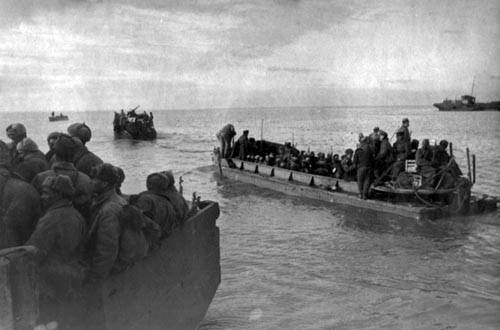
German plans and forces
The command of the 11th German army considered the possibility of an enemy landing. However, Army Commander Manstein noted that the army did not have a mobile reserve to fend off such a threat. Therefore, the most dangerous sections of the coast were covered by infantry. The main forces of the 46th Infantry Division of the 42nd Army Corps of General Sponek were located in the Kerch region. The 46th division was tasked with repelling the landing forces and destroying the landed enemy forces.
In total, together with Romanian units, artillery, anti-aircraft and coastal units, the German Kerch group numbered about 10 thousand people.
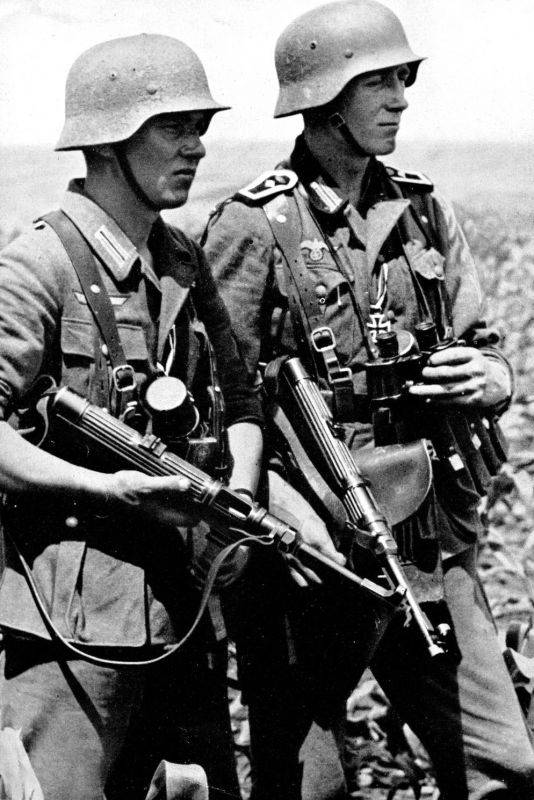
Soldier and sergeant major of the Crimean group of the Wehrmacht, distinguished themselves in the battles for Kerch, awarded with iron crosses of the 2nd class. They are armed with MP-38 submachine guns.
The beginning of the Kerch operation
On December 24, 51st Army received the order to start the operation. The disembarkation was scheduled for 5:26. December 24. The troops began to concentrate in Temryuk. On the evening of the 25th, landing began, and by the morning of the 24th it was completed. In the afternoon, in the evening and at night on December 25-XNUMX, transports left the Temryuk, Kuchugury, Taman and Komsomolskaya docks. At the end of the day, the weather worsened, which complicated the landing.
Admiral Gorshkov recalled:
Due to a storm, headwind and strong waves, the transports were 2-6 hours late with the landing, and the landing was carried out in daylight. The landing took place with great problems and losses. So, the 1st detachment, delayed by the storm, did not reach the Kazantip Bay and the landing force was landed somewhat west of the 2nd detachment. About 200 people were landed under the command of Lieutenant Kapran.
The 2nd detachment (over 2,8 thousand paratroopers) approached the coast in the area to the west of Cape Zyuk by 7 o'clock. December 26. The seiners could not approach the shore because of the draft, the boats were thrown ashore and wrecked. The paratroopers went ashore up to their chests in the icy water. There was no way to unload heavy weapons. In the middle of the day, enemy aircraft appeared. The tugboat "Fanagoria" was killed - 100 dead. In the evening, the barge "Khoper" was put on the coast, a gangway was made and unloaded 2 tank and artillery. In total, about 900 people were landed in a day.
This sector of the Germans was defended by a communications battalion, so the resistance was small. To fend off the Soviet landing, the German command put forward two battalions of the 97th Infantry Regiment of the 46th Division, located in the depths and on the coast of the Kazantip Bay. The Germans planned to set up barriers at the heights to the west of Lake Chokrak.
The 3rd detachment (more than 1 thousand fighters) at Tarkhan, under fire from the coast and the air, was able to land only about a platoon. An air strike destroyed the Voroshilov dredger, killing 450 people. Another 200 people were rescued by other ships. The minesweeper "Hurricane" overcrowded with rescued people left for Temryuk. The 4th detachment (about 2200 people) landed at Chroni most successfully. Barge "Taganrog" successfully landed troops and was used as a pier. Three battalions (over 1500 soldiers) and 3 tanks were landed. The airborne detachment was led by the commander of the 83rd Marine Brigade, Colonel Leontyev, who immediately launched an attack on Adzhimushkai. The 5th Detachment of the 26th could not land. The storm upset the movement of ships, the minesweepers lost ships and boats in tow. Had to go back to search.
Thus, on the first day of the operation, about 2500 paratroopers were landed on a wide front, the landing areas were only partially saved, part of the landing force returned back, some were sunk by German aircraft. That is, it was, if not a failure, then a great failure of the landing force landed by the Azov flotilla.
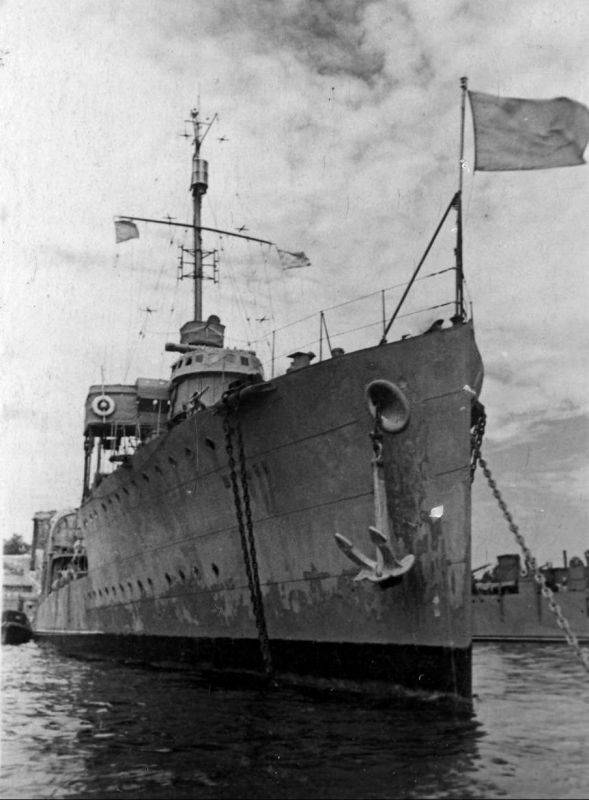
The destroyer of the Black Sea Fleet "Shaumyan" (type "Fidonisi" - "Ushakovskaya" series of destroyers of the "Novik" type) at the pier
Kerch Strait area
The ships of the Kerch naval base took on board three detachments of the 302nd Mountain Division. More than 5 thousand people in total. The organization of boarding was unsatisfactory, which was exacerbated by stormy weather. The ships were late in reaching the place of disembarkation, some during the transition at night in stormy conditions, when the storm was torn off the fence of dangerous areas, ran aground. The ships were removed from the shallows and went to the shore in the daytime. Therefore, by 5 o'clock in the morning on December 26, almost according to the schedule, only the 1st detachment, consisting of 20 seiners and 8 torpedo boats (more than 1,1 thousand people), went to Eltigen, Kamysh-Burun and Old Quarantine. The paratroopers settled on the Kamysh-Burunskaya spit and the pier of the shipyard. The landing was actively supported by artillery, the Germans noted that the entire coast was under fire from the enemy's heavy guns from the opposite coast. The Germans counterattacked with battalion forces supported by artillery. But the Russians settled in the old field fortifications and successfully fought back. From the sea, they were supported by gunboats with fire.
Other units were less fortunate. Due to the strong opposition of the enemy in Old Quarantine, only 55 soldiers were able to land, led by the 1st rank quartermaster technician Grigoriev. The rest of the landing went to Kamysh-Burun. The Germans quickly defeated Grigoriev's group. 19 paratroopers who landed in Eltigen, led by Major Lopata, fought surrounded and died.
The next wave of landing at about 7 o'clock already met more powerful fire resistance from the Germans. Some of the ships turned back to Taman. The main part of the landing force lands in the area of the Kamysh-Burunskaya spit and the pier of the shipyard. Also, the landing was able to land south of Eltigen and gain a foothold in the iron factory. The third wave came at 13 o'clock. A large transport became a victim of artillery and enemy aircraft, up to 300 soldiers and the entire materiel of the 823rd regiment were killed. Part of the landing reached the shore by swimming, but she was without weapons... He was obviously dumped to be saved. Another barge with the main forces of the 825th regiment (up to 1000 people) caught fire and returned to Taman.
As a result, about 2200 people were landed on the Kerch coast. Of these, 1500 are in Kamysh-Burun, 120 are on Kamysh-Burunskaya spit and 500 are south of Eltigen. It was not possible to land the main forces of the 302nd division. Small groups were destroyed by the Germans. On the same day, an attempt was made to land troops near the town of Opuk. But the wind scattered the court in the darkness. Therefore, the commander of the landing, Rear Admiral Abramov, who arrived at the scene in the gunboat "Red Ajaristan", decided to return to Anapa, collect the ships and try again on the 27th.
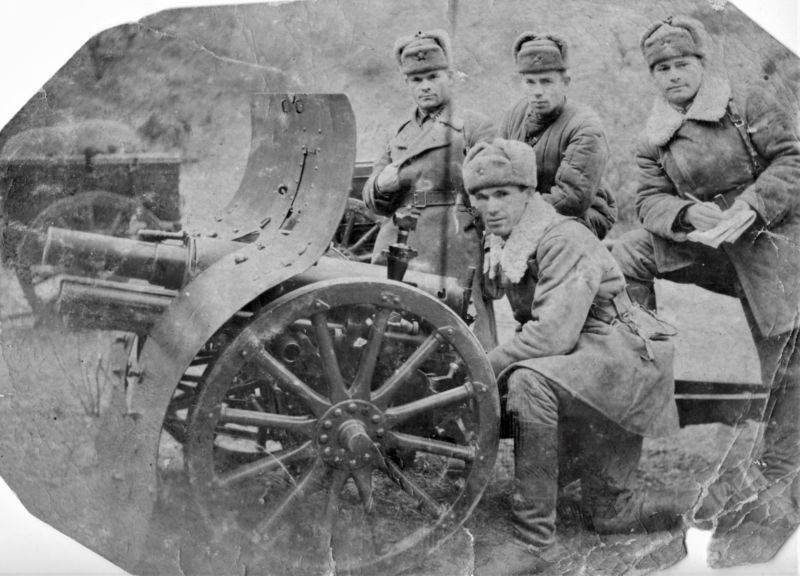
Servicemen of the Red Army - participants of the Kerch-Feodosia landing operation at the 76-mm mountain gun of the 1909 model
Heavy fighting. The death of a part of the airborne troops
On December 27, 1941, it was not possible to turn the tide in our favor. There was a severe storm at sea and it was not possible to reinforce the landing. The Germans tried to destroy the landed forces with counterattacks. The 97th Infantry Regiment counterattacked the 2nd Detachment near Cape Zyuk. Ours also tried to attack, lost 3 tanks. The Germans blocked the detachment on the cape by mining the isthmus.
The 4th detachment of Leontyev tried to develop an offensive on Adzhimushkai. The Germans repulsed the attack, and they themselves counterattacked with the forces of two battalions of the 72nd Infantry Regiment. However, the Soviet paratroopers put up stubborn resistance and were supported by ship fire. Attempts by the Germans to throw units of the 302nd division into the sea were also unsuccessful. Soviet troops were supported by fire from the other side of the strait and ships. At the same time, the Germans are strengthening their defenses in the Kerch region with 20- and 88-mm anti-aircraft guns, and a battalion of the 97th Infantry Regiment, withdrawn from Feodosia, arrives. The Germans are gathering shock groups on the northern coast of the Kerch Peninsula, providing them with artillery support.
On December 28, our troops were able to resume the landing. In the area of Cape Chroni, up to 400 people were able to land. But on the whole, the situation is developing badly for our troops. In the morning, the Germans with the forces of two battalions of the 97th regiment attacked the positions of the 2nd detachment, by noon the landing was defeated. The Soviet paratroopers took their last battle off the coast. The Germans noted: the enemy
The Germans defeated the detachment of Colonel Leontyev (4th detachment). The paratroopers retreat to Cape Tarkhan and continue to resist on the shore and in the quarries. The detachment of Lieutenant Kapran (1st detachment) was cut off from the sea and blocked.
South of Kerch, the situation was less dramatic. More than 600 fighters landed in the Kamysh-Burun area at night. However, the attempt of the Soviet troops to expand the bridgehead and connect with the detachment at Eltigen did not succeed. As well as the attempts of the Germans to destroy our bridgeheads at Kamysh-Burun and Eltigen. Detachment "B" of the 44th Army (2,3 thousand people) was also aimed here, in Kamysh-Burun. The disembarkation went badly. The ships ran aground 50-150 meters from the coast, the troops were transported by boats.
Thus, by the morning of December 29, the landing was under the threat of complete defeat. The command of the 11th German Army was confident that the situation on the Kerch Peninsula was under control and the enemy landing force would be destroyed. At the talks with A.M. Vasilevsky, held on the night of December 28-29, the front commander D. T. Kozlov admitted:
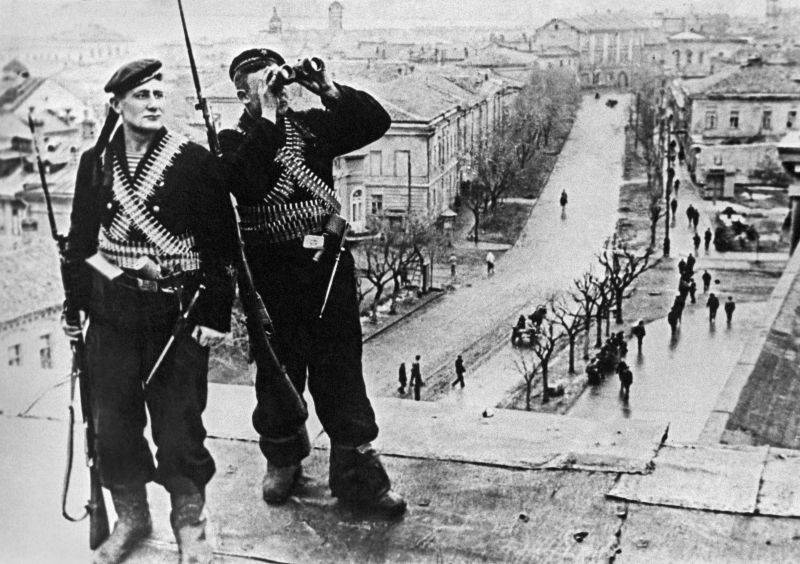
Red Navy men conduct surveillance on the roof of a house in liberated Kerch (the first liberation of the city)
Landing in Feodosia
The situation was changed by the landing in Feodosia, in the rear of the German Kerch group. While on the Kerch Peninsula the Germans tried to break the resistance of the Soviet landings pressed to the sea, on December 28 in Novorossiysk, the landing of the first echelon, Detachment A (5,4 thousand soldiers) began on the cruisers Krasny Kavkaz and Krasny Krym, and the destroyers Zheleznyakov "," Shaumyan "," Nezamozhnik "and transport" Kuban ", patrol boats. The best units went first: a regiment of the 9th Mountain Rifle Division, a regiment of the 157th Rifle Division and a Marine battalion.
And the materiel began to be loaded in Novorossiysk and Tuapse on transports back on December 26. A total of 1 thousand people (11,2th division), 236 26-mm guns, 45 18-mm guns, 76 7-mm howitzers, 122 vehicles, 199 light tanks, etc. were loaded onto the transports of the 20st detachment. For the 2nd detachment of transports: 6,3 thousand people (63rd mountain rifle division without one regiment), 31 76-mm guns, 27 122-mm howitzers, 92 vehicles, 14 tanks, etc. That is, Soviet the command gathered a large force to turn the tide in their favor.
On the one hand, the moment was favorable. The command of the German 42 Corps weakened the defenses of Feodosia in order to strengthen the troops in the Kerch region. On the other hand, the command of the 11th German army sent from the Sevastopol region the last reserve - the 46th sapper battalion (a separate motorized unit). The battalion, together with the construction companies, was to build a defensive position at the narrowest point of the peninsula from Ak-Monai to the south. On the 28th, the 46th battalion was on the march from Karasubazar to Ak-Monai and went to the Feodosia area in the afternoon. Also in Feodosia at that time there was a heavy weapons company of the 186th infantry regiment, two artillery battalions, a team of assault boats (100 people), an anti-tank company and a coastal battery.
At 3 am on December 29, Soviet ships sailed to Feodosia. Under cover of naval artillery fire, the boats entered the harbor and landed an assault detachment (266 fighters), which captured the lighthouse and two anti-tank guns. Then the destroyers entered the harbor, which by 7 o'clock. landed troops (about 900 people). The landing of the Russians was unexpected for the Germans. The 46th Sapper Battalion was not intended to defend the city; it did not have a plan in this regard. The senior commander in Feodosia, the chief of the sapper units of the 11th Army, Böhringer, contacted the army headquarters and received orders to defend each quarter. But he makes a different decision: to withdraw the sappers from Feodosia and take the fork in the Kerch-Simferopol roads (on the outskirts of the city). This decision is very doubtful, since at this time the German artillerymen put up strong resistance to our troops and, with the support of sappers, could clearly inflict even more damage on them.
So, the German artillerymen were able to provide strong resistance to the enemy. The cruiser Krasny Kavkaz was able to land a landing with great difficulty, but received heavy damage from enemy fire (28 people were killed and 76 were wounded) and barely reached Novorossiysk. Also, two destroyers, a minesweeper, 4 patrol boats, 2 transports were damaged, 3 patrol boats and 2 transports were sunk. The German command reacted immediately to the appearance of the Russians in Feodosia. Already in the morning, the Romanian 4th Mountain Rifle Brigade, 4th Motorized Regiment Corne, and an anti-tank battalion were sent to Feodosia. Aviation was instructed to act only in Feodosia. Manstein holds a meeting, finds out what forces, primarily artillery, can be transferred to Feodosia. One regiment of the 170th division was withdrawn from the battle and transferred to Alushta. Another regiment is preparing to withdraw from the battle in Sevastopol.
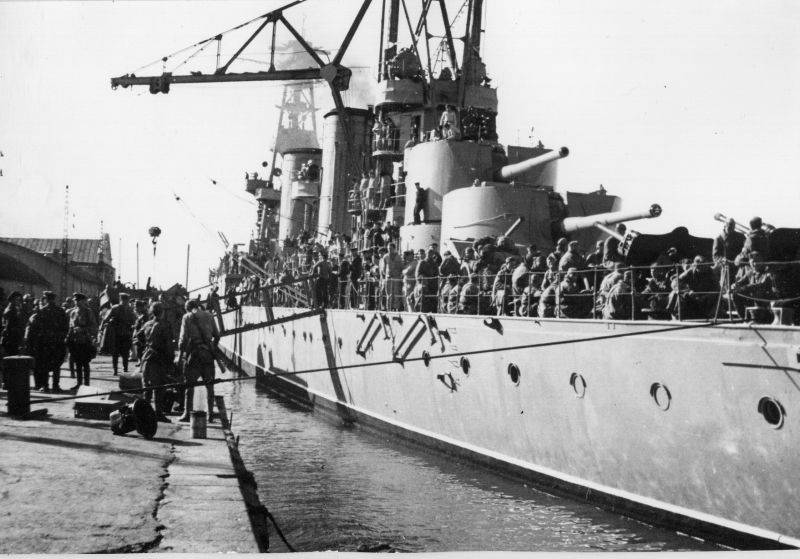
Landing of the marching replenishment on the cruiser "Krasny Kavkaz" to be sent to Sevastopol
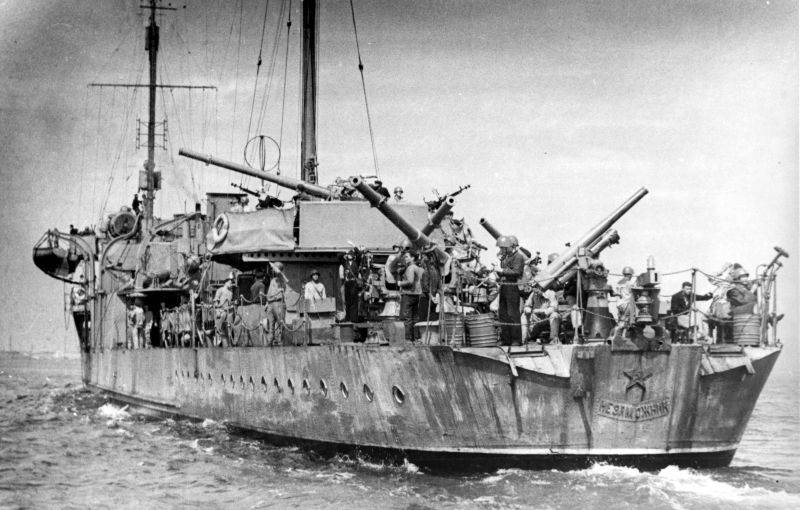
Soviet destroyer "Nezamozhnik" of the "Fidonisi" type, which was one of the destroyers of the "Novik" class, at sea
Kerch region. Retreat of the Germans
In the eastern part of the Kerch Peninsula, on December 29, the Germans tried to finish off the Soviet landing forces. According to German data, Leontiev's detachment was finished off. Kapran's detachment tried to break through to the sea, which forced the 97th Infantry Regiment to go on the defensive. At Kamysh-Burun, Soviet troops tried to attack, but without success.
But the very fact of the Soviet landing in the rear, in Feodosia, demoralized the headquarters of the 42nd Army Corps. By noon, Manstein orders the 46th Division to destroy the Soviet landing in Feodosia. Departure was prohibited. However, even earlier, Corps Commander Sponek ordered the 46th Division to leave the Kerch Peninsula. Manstein flew into a rage and removed Sponeck from command. The general was arrested and sentenced to death. Hitler commuted execution to imprisonment. As a result, after the attempt on Hitler's life, Sponeck was executed by order of Himmler in 1944.
Sponek not only ordered the abandonment of the peninsula, but also turned off the radio so as not to hear the restraining order in response. The 46th Division successfully withdrew from the peninsula, but retained its heavy weapons. Our troops have captured rich trophies. The casualties of the German division from December 25, 1941 to January 3, 1942 were small - about 1 people killed, wounded and missing. The German sappers withdrawn from Feodosia are trying to take a defensive position, but they soon bypassed them, and they retreated. From Feodosia, abandoning the materiel, the German artillerymen also leave. By the morning of December 30, Feodosia was liberated from the remnants of German troops. 2 thousand Red Army men were released from captivity. At this time, a Romanian mountain brigade approached, which they planned to throw in a counterattack. But the Romanians could not be roused to the offensive. The Romanian officers remained in the rear, as did the artillery.
Meanwhile, the Soviet units that had landed in Feodosia went on the offensive. The appearance of Russian tanks played a decisive role. The Germans noted:
The Romanian brigade and the 46th Sapper Battalion retreat.
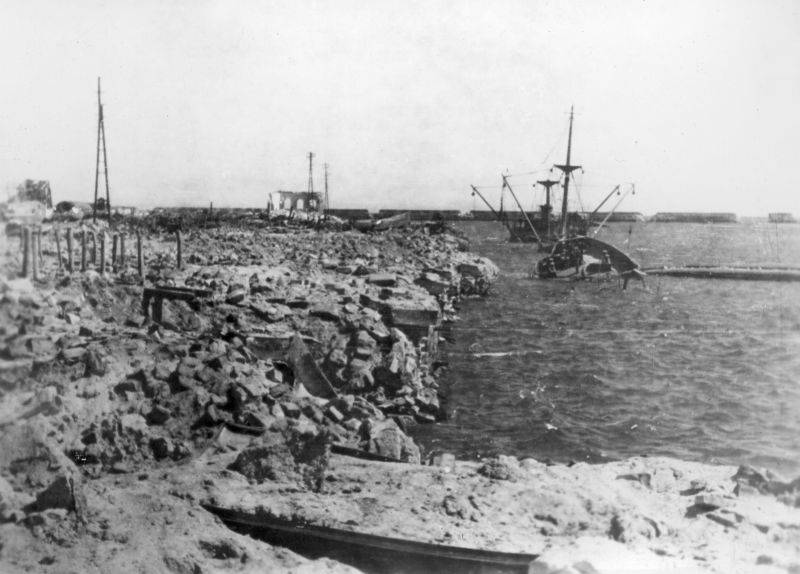
View of the destroyed port of Feodosia
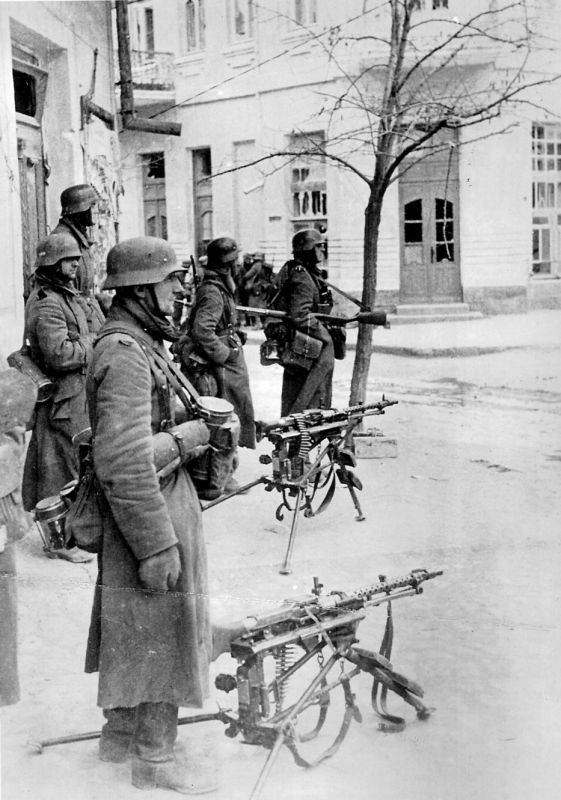
Wehrmacht soldiers on the streets of Feodosia
Completion of the operation. 11th Army's counterstrike
On December 29-31, 1941, 23 thousand soldiers, 34 tanks, 109 guns, 24 mortars, 334 cars and tractors, etc. are landed in Feodosia. Our troops advanced 10-15 km and liberated Vladislavovka. The approaching Romanian units could not throw the Russians into the sea, but managed to hold out until the German troops approached. At the headquarters of the 11th Army, the situation is assessed as threatening the entire army and positions in the Crimea. It is proposed to stop the assault on Sevastopol and strengthen the 42nd corps at the expense of the 54th corps. As a result, the assault on Sevastopol was stopped.
On January 1, 1942, the troops of the 44th Army could not advance. On January 2, our troops reached the Kiet, Nov. Pokrovka, Iziumovka, Koktebel, where they met strong enemy resistance. The landing of the 51st Army continued, but proceeded slowly due to the ice situation in the strait. The Soviet command planned to develop an offensive and liberate Crimea with a blow to Perekop. But it was not possible to quickly concentrate the troops, to supply them with everything necessary. Therefore, it was not possible to go on the offensive on the move while the enemy was not yet ready. The troops of the 51st Army did not have time to stand up as a second echelon behind the 44th Army.
Air cover was still poor. The airbases of the Transcaucasian Front were far away. The Luftwaffe had air superiority. German bombers successfully attacked our transports in Feodosia, disrupting the accumulation of weapons, equipment and supplies. The first to die was "Tashkent", followed by "Zyryanin" (fuel and shells) and "Nogin" on 4 January. On January 9, "Spartakovets" and "Chatyr-Dag" were destroyed. On January 16, he died on a mine "Jean Jaures".
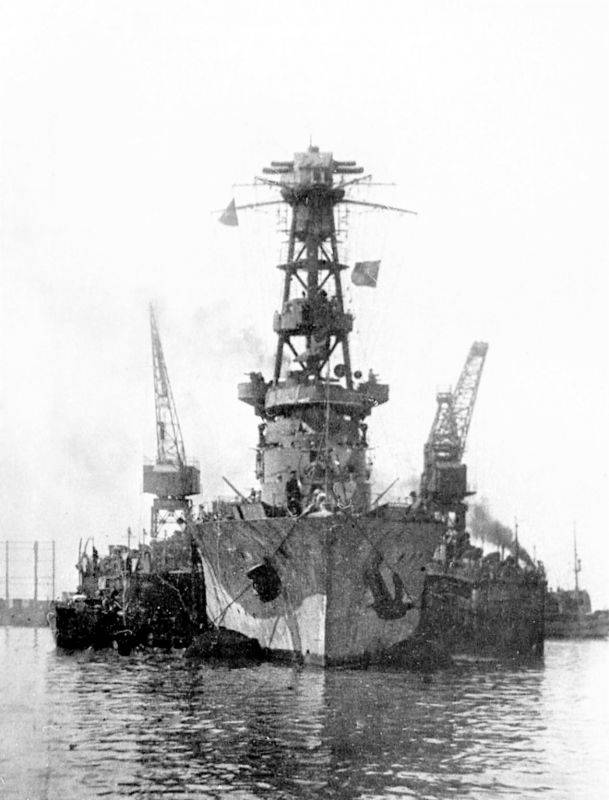
Light cruiser of the Black Sea Fleet "Krasny Kavkaz" in a floating dock during a major overhaul in Poti. On January 4, 1942, the cruiser delivered an air defense brigade to Feodosia. During unloading, it was attacked by Ju-87 dive bombers carrying 500 kg of bombs. As a result of the attack, the cruiser received three holes below the waterline. The cruiser was delivered for a major overhaul in Poti. "Krasny Kavkaz" was repaired from March 26 to August 17, 1942. Due to the loss of part of the ship repair capacity and the lack of a dock of the required carrying capacity, it was necessary to develop and calculate a previously unused method with incomplete entry of the hull into the dock (the bow of the cruiser remained afloat). During the repair, the anti-aircraft armament of the cruiser was significantly strengthened.
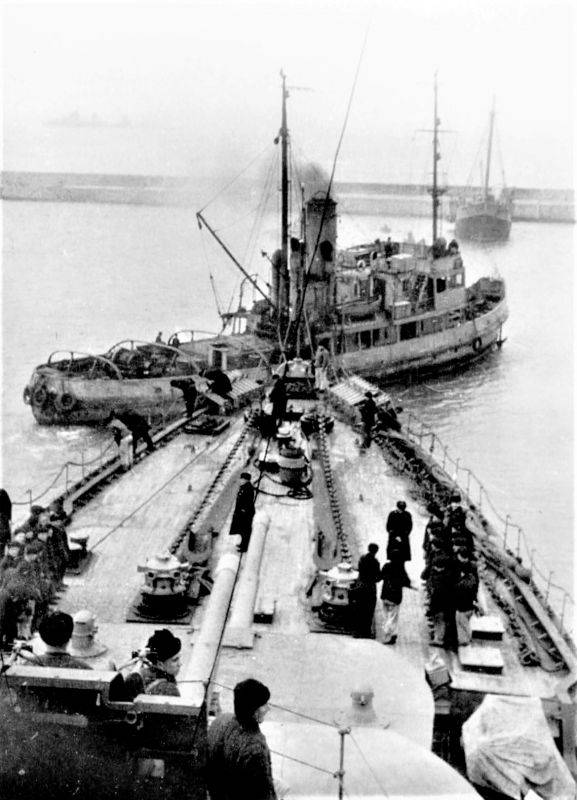
The tug assists the cruiser "Krasny Kavkaz" in maneuvering when leaving the port
The German command was the first to manage to regroup its forces and prepare for a new battle. The 170th and 132nd German divisions and the 8th Romanian brigade were concentrated, and the Germans achieved a qualitative and quantitative superiority in the direction of the strike. On January 15, 1942, the Germans attacked and on the 18th recaptured Feodosia. Part of the forces of the 44th Army fell into the "cauldron". The Germans reported 10 thousand prisoners. Army commander Pervushin was seriously wounded, a member of the Military Council A.G. Komissarov was killed, and the chief of staff, Colonel S. Ye. Rozhdestvensky, was wounded. General I.F.Dashichev took over the command of the army. The remnants of the divisions of the 44th Army remained. Our troops retreated beyond the Ak-Monaysky Isthmus and lost the main port through which the army was supplied. The Transcaucasian Front went over to the defensive.
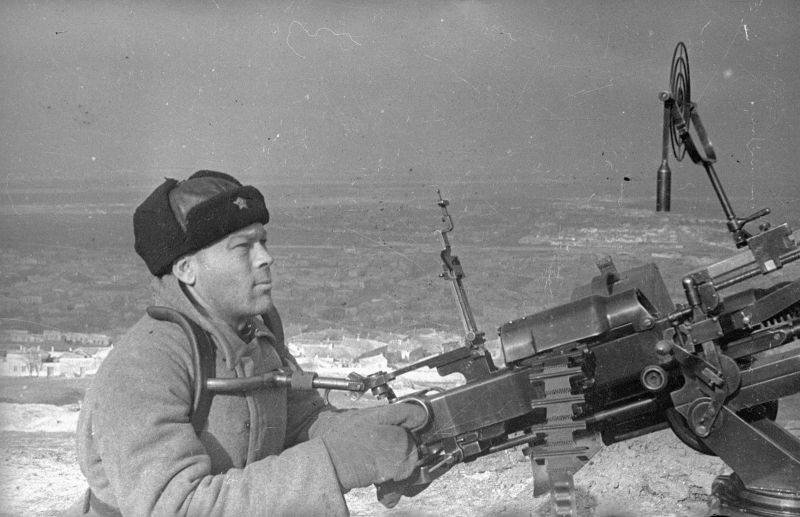
Red Army soldier S. Sneemushkin at the sight of a 12,7-mm DShK anti-aircraft machine gun on Mount Mithridat
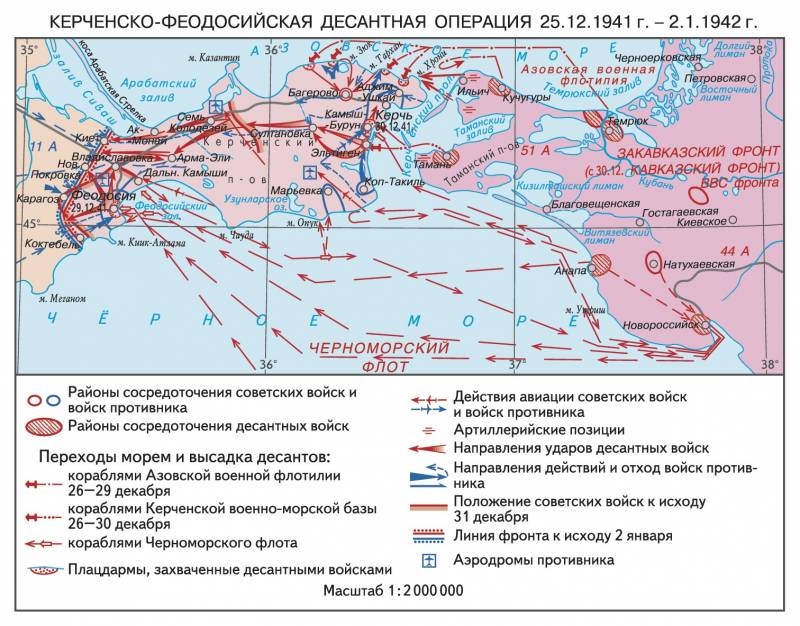
Information